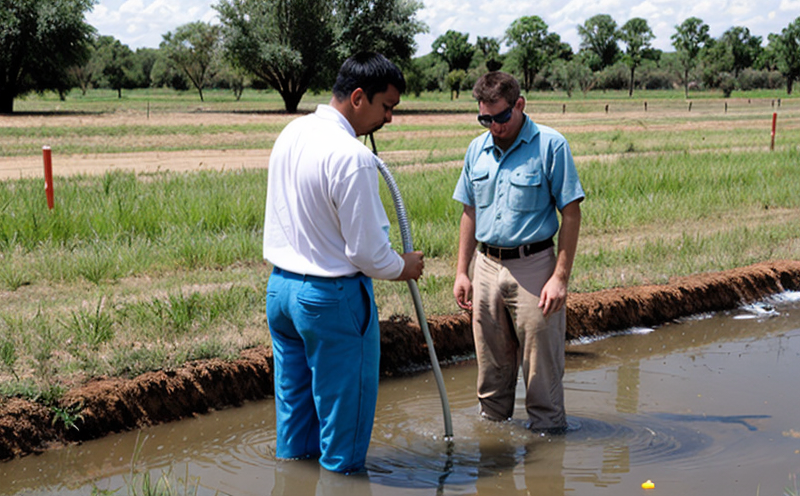ASTM D516 Sulfate Determination Test in Groundwater
The ASTM D516 sulfate determination test is a critical method used to quantify the concentration of sulfates in groundwater. This test is essential for environmental monitoring, compliance with regulatory standards, and ensuring water quality meets acceptable thresholds.
Sulfates are naturally present in many groundwater sources but can also be introduced through industrial activities or agricultural runoff. Elevated levels of sulfate can lead to issues such as increased corrosivity of pipes, formation of hydrogen sulfide gas which causes a foul odor, and potential harm to aquatic life if the concentration is too high.
The ASTM D516 method typically involves a digestion step followed by a colorimetric analysis using a reagent that reacts specifically with sulfate ions. The intensity of this reaction is then measured against a calibration curve to determine the exact concentration of sulfates in the sample.
This test plays a vital role for various sectors including municipal water utilities, agricultural operations, and industrial facilities handling large amounts of groundwater. Compliance officers need accurate data to ensure that their processes do not exceed permissible limits set by regulatory bodies like the Environmental Protection Agency (EPA).
Quality managers rely on this testing to maintain consistent product quality while R&D engineers use it as part of their research into sustainable water resource management practices.
- Accuracy: The accuracy of ASTM D516 is paramount for ensuring reliable results. Careful attention must be paid during sample preparation and analysis to minimize any potential errors.
- Durability: Equipment used in this process should withstand frequent use without degradation, maintaining precision over time.
- Sensitivity: The method needs to have sufficient sensitivity to detect even trace amounts of sulfate which may be indicative of contamination or natural presence at low levels.
In summary, the ASTM D516 test is indispensable for assessing sulfate content in groundwater. It provides critical insights necessary for effective environmental management and regulatory compliance across multiple industries.
Why It Matters
The determination of sulfate concentration through ASTM D516 has significant implications for various stakeholders within the environment sector. Sulfates play a crucial role in determining water quality standards, especially when it comes to protecting human health and aquatic ecosystems.
For municipal water utilities, compliance with EPA regulations is non-negotiable. Failure to meet these standards can result in costly fines and damage to public trust. By implementing ASTM D516 testing protocols, they ensure that their treated waters are safe for consumption without compromising taste or odor.
Agricultural operations also benefit greatly from this test as it helps them manage irrigation practices more efficiently. Excessive sulfate levels could lead to soil salinization affecting crop yields negatively. Therefore, regular monitoring using ASTM D516 ensures sustainable farming practices.
Industrial facilities dealing with substantial volumes of groundwater must adhere strictly to internal safety protocols and external regulatory requirements. The ASTM D516 test serves as a key tool in identifying potential risks early on before they escalate into major issues.
In conclusion, the ASTM D516 sulfate determination test is not just about measuring sulfate concentrations; it's about safeguarding public health, supporting sustainable agricultural practices, and maintaining industrial operations within legal boundaries. Its importance cannot be overstated for any organization operating in sectors reliant on groundwater resources.
Scope and Methodology
The ASTM D516 standard specifies the procedure for determining the concentration of sulfate ions (SO₄²⁻) in water samples by means of a colorimetric method. This involves digesting the sample under controlled conditions followed by titration or spectrophotometric measurement.
Sample preparation is critical and includes filtering to remove particulate matter, adjusting pH if necessary, and diluting if needed before analysis. The digestion step ensures all organic matter is broken down allowing for accurate sulfate quantification.
The actual determination process uses a reagent that reacts specifically with sulfate ions producing a colored complex whose intensity correlates directly with the sulfate concentration present in the sample. This reaction generates a visible change which can be measured spectrophotometrically or compared against standard solutions to calculate the exact amount of sulfate.
Acceptance criteria for ASTM D516 require that the reported value fall within specified limits based on acceptable levels of sulfate according to relevant regulatory guidelines such as EPA standards. Laboratories must ensure their methods comply with these stringent requirements ensuring accurate and reliable results.
Quality and Reliability Assurance
To maintain high-quality results, laboratories adhere strictly to ASTM D516 procedures while implementing rigorous quality control measures. Regular calibration of equipment is crucial to ensure consistent performance over time.
- Calibration: All instruments used in the analysis must be regularly calibrated against certified reference materials to guarantee accurate measurements.
- Standard Solutions: Preparing and storing standard solutions according to specified protocols ensures they remain stable and reproducible throughout their intended use period.
- Blank Controls: Conducting blank runs helps identify any sources of contamination or interference that might affect the accuracy of individual analyses.
- Duplicate Samples: Performing duplicate determinations on each sample provides additional confidence in reported results by allowing detection and correction of errors if they occur.
In addition to these technical controls, laboratories also participate in proficiency testing programs organized by recognized bodies like A2LA or NELAC to validate their analytical capabilities against those of other accredited labs. By adhering strictly to ASTM D516 guidelines along with internal quality assurance protocols, we deliver reliable sulfate concentration data that meets all necessary regulatory requirements.





